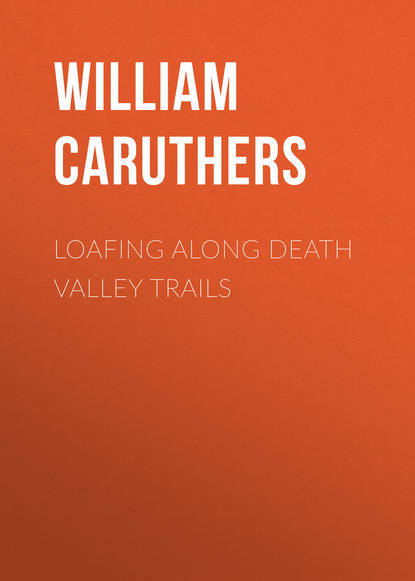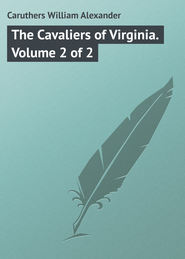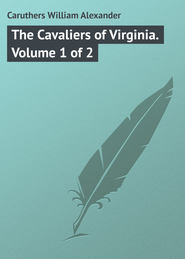По всем вопросам обращайтесь на: info@litportal.ru
(©) 2003-2024.
✖
Loafing Along Death Valley Trails
Настройки чтения
Размер шрифта
Высота строк
Поля
Blood vengeance was deep-rooted. Found with the Indian collection of Dr. Simeon Lee at Carson City was a revealing manuscript that tells how swiftly it struck.
Mudge rode up to another Indian standing on a Carson City street and without warning shot him dead and galloped away. The dead man had two cousins working at Lake Tahoe. The murder had occurred at 9:30 a.m. and by some means of communication unknown to whites, they were on Mudge’s trail within two hours and had found him. Mudge promptly killed them both and fled again. Sheriff Ulric engaged Captain Johnnie, a Piute, to track the slayer. He found Mudge’s lair, but Mudge was a sure shot, well protected and to rush him meant certain death. The posse decided to keep watch until thirst or hunger forced him out. “Me fix um,” said Captain Johnnie.
He disappeared, but soon returned with an enormous amount of tempting food which he contrived to place within easy reach of Mudge. “Him see moppyass (food). Eat bellyful and fall down asleep.”
That is exactly what happened and old Demi-John, the father of the murdered boys crawled stealthily through the sage and with his hunting knife severed the head from the sleeping Mudge’s body.
In Mono county Piutes killed the Chinese owner of a cafe and fed the carcass to their dogs. In court they blandly confessed and justified it, claiming the Chinaman had killed and pickled one of their missing tribesmen and then sold and served to them portions of the victim as “corned beef and cabbage.”
For the desert Indian life was raw to the bone. He was an unemotional, fatalistic creature as ruthless as the land. In the struggle to live, he had acquired endurance and cunning. He knew his desert – its moods, its stingy dole, its chary tolerance of life. He knew where the mountain sheep hid, the screw-bean grew and the fat lizard crawled. He knew where the drop of water seeped from the lone hill. He combed the lower levels of the range for chuckwalla, edible snakes, horned toads – anything with flesh; stuffed the kill into bags and preserved them for later use. He made flour from mesquite beans; stored piñons, roots, herbs in his desperate fight to survive, and anything that crawled, flew, or walked was food. I have seen a squaw squatted beside the carcass of a dog, picking out the firmer flesh.
When the Piute came to a spring, the first thing he did was to look about for a flat rock which he was sure to find if a member of his tribe had previously been there. Kneeling, he would skim the water from the surface and dash it upon this rock. Then he smelled the rock. If there was an odor of onion or garlic, he knew it contained arsenic and was deadly. Naturally, he would be concerned about another water hole. He had only to look about him. He would find partially imbedded in the earth several stones fixed in the form of a circle not entirely closed. The opening pointed in the direction of the next water. The distance to that water was indicated by stones inside the circle. There he would find for example, three stones pointing toward the opening. He knew that each of those stones indicated one “sleep.” Therefore he would have to sleep three times before he got there. In other words, it was three days’ journey.
But which of these trails leading to the water should he take? There might be several trails converging at the water hole. The matter was decided for him. He walked along each of those trails for a few feet. Beside one of them he would find an oblong stone. By its shape and position he knew that was the trail that led to the next water.
Under such circumstances a man would perhaps wonder if upon arrival at the next water hole he would find that water also unfit to use. The information was at hand. If, upon top of that oblong stone he found a smaller stone placed crosswise and white in color, he knew the water would be good water. If a piece of black malpai was there instead of the white stone, he knew the next water would be poison also.
Not infrequently he would find other information at the water hole if there were boulders about, or chalky cliffs upon which the Indian could place his picture writing. If he saw the crude drawing of a lone man, it indicated that the land about was uninhabited except by hunters, but if upon the pictured torso were marks indicating the breasts of a woman, he knew there was a settlement about and he would find squaws and children and something to eat.
Frequently other information was left for this wayfaring Indian. Under conspicuous stones about, he might find a feather with a hole punched through it or one that was notched. The former indicated that one had been there who had killed his man. The notch indicated that he had cut a throat.
Since there was a difference between the moccasins of Indian tribes, the dust about would often inform him whether the buck who went before was friend or enemy.
Like all American aborigines, the Piute had his medicine man, but the manner of his choosing is not clear. The one selected had to accept the role, though the honor never thrilled him, because he knew that when the score of death was three against him he would join his lost patients in the happy hereafter. Occasionally he was stoned to death by the relatives of the first lost patient and with the approval of the rest of the tribe. Not infrequently it was believed the medicine man’s departed spirit then entered the medicine man’s kin and they were also butchered or stoned to death.
Note. Early writers refer to Pau Eutahs, Pah Utes, Paiuches, Pyutes, and Paiutes. The word Piute is believed to mean true Ute.
Bancroft claimed the Piutes and Pah Utes were separate tribes, the latter being the Trout or Ochi Indians of Walker River; the former the Tule (or Toy) Indians of Pyramid Lake.
There was an undetermined number of branches of the original Utah stock. Besides the above, there was another tribe called by other Indians, Cozaby Piutes, Cozaby being the Indian name of a worm that literally covered the shores of Mono Lake. This worm was a principal food of the tribe.
Though “Piute” is the spelling justifiably used throughout the region, “Pahute” was chosen a few years ago by a group of scholars as the preferable form.
Chapter VIII
Desert Gold. Too Many Fractions
On the Nevada desert wind-whipped Mount Davidson (or Sun Mountain) guided the Forty Niners across the flat Washoe waste. At its foot they rested and cursed it because it impeded their progress to the California goldfields. Ten years later they rushed back because it had become the fabulous Comstock, said to have produced more than $880,000,000, though the Nevada State bureau of mines places the figure at $347,892,336. The truth lies somewhere between.
“Pancake” Comstock had acquired, more by bluff and cunning than labor, title to gold claims others had discovered and cursed a “blue stuff” that slowed the recovery of visible particles of gold. Later the “blue stuff” was blessed as incredibly rich silver. A mountain of gold and silver side by side. It just couldn’t be.
A new crop of overnight millionaires. New feet feeling for the first step on the social ladder. The Mackays, the Floods, the Fairs, the Hearsts.
All this was more like current than twenty year old history to Jim Butler on May 18, 1900, when his hungry burro strayed up a hill in search of grass. Soon a city stood where the burro ate and soon adventurers were poking around in the canyons of Death Valley, 66 miles south.
Jim Butler, more rancher than gold hunter was a likable happy-go-lucky fellow, who could strum a banjo and sing a song. But when he found the burro in Sawtooth Pass he saw a ledge which looked as if it might have values. Born in El Dorado county in California in 1855, Butler was more or less gold conscious, but unexcited he stuck a few samples in his pocket and went on after the burro.
A story survives which states that a half-breed Shoshone Indian known as Charles Fisherman had told Butler of the existence of the ore without disclosing its location and that Butler was actually searching for it when the burro strayed. The preponderance of evidence, however, indicates that Butler was en route to Belmont to see his friend, Tasker Oddie, who was batching there in a cabin. He gave Oddie one of the samples and after his visit, left for home.
Oddie laid the sample on a window sill and forgot it.
In Klondike a few days later, Butler showed another sample to Frank Higgs, an assayer. Half in jest he said: “Frank, I’ve no money to pay for an assay, but I’ll cut you in on this stuff if it shows anything.”
Higgs looked at the sample and returned it to Butler: “Just a waste of time. Forget it.”
Later in Belmont Henry Broderick, a prospector dropped in for a visit with Oddie and noticed the sample Butler had given Oddie and looked it over. “This ore has good values,” he told Oddie. “It’s worth investigating.” Oddie knew that Broderick’s opinion was not to be underrated.
Oddie was a young lawyer with little practice and a salary of $100 a year as District Attorney. Belmont had a population of 100. Oddie didn’t have two dollars to risk, but he took the sample to W. C. Gayhart at Austin and offered Gayhart a fractional interest if he’d assay it. With few customers, Gayhart took a chance.
The ore showed values and Oddie was mildly excited. Butler lived 35 miles away in wild, difficult country and Oddie wrote him, enclosing the assay. Several weeks passed before Butler received the letter. Then Butler and his wife returned to Belmont only to find Oddie could not go with them. Jim and Mrs. Butler now returned home, loaded provisions, tools, and camp equipment in a wagon and three days later, Aug. 26, 1900, they reached Sawtooth Pass and made camp.
The Butlers staked out eight claims. Jim took for himself the one he considered best. He named it The Desert Queen. Mrs. Butler chose another and called it Mizpah. Jim located another for Oddie and named it Burro. The best proved to be Mrs. Butler’s Mizpah.
Returning to Belmont, they found Oddie at home. The matter of recording the location notices had to be attended to. “That will cost ten or fifteen dollars,” Butler said. Neither of them had any money. Wils Brougher was recorder of Nye county and Oddie’s friend, so Oddie made a proposition to Brougher. “If you’ll pay the recorder’s fees we’ll give you an eighth.”
Brougher said, “Nye county is one of the largest counties in the United States, but there are only 400 people in it and I’m not getting many fees these days. Leave ’em.”
After they’d gone Brougher looked at the assay Oddie had left and decided to take a chance. The setup was now: Butler and his wife five-eighths, Oddie, Brougher, and Gayhart, one-eighth each.
They managed to pool resources and obtained $25 in cash to provide material and provisions.
Brougher, Oddie, Jim, and Mrs. Butler set out in October, 1900. Mrs. Butler did the cooking while the men dug, drilled, and blasted two tons of ore. The ore was sacked and hauled 150 miles to Austin and shipped to a San Francisco smelter. The returns showed high values but still they had a major problem – money to develop the claims. Because the country had been prospected and pronounced worthless, men of millions were not backing a banjo-picking rancher and a young lawyer with no money and few clients. The answer was leasing to idle miners willing to gamble muscle against money. The venture made many of them rich. The others recovered more than wages. As the leases expired the owners took them over.
The camp where Mrs. Butler cooked became the site of the Mizpah Hotel and the City of Tonopah and the hill where the burro strayed produced many millions.
There are several versions of the Butler discovery and the writer does not pretend that his own is the true one. He can only say that he knew many of those who were first on the scene and some of those who held the first and best leases, and his conclusions are based on their personal narratives.
Oddie became one of the moguls of mining, Nevada’s governor, and a senator of the United States.
Twenty-six miles south of Tonopah was a place known as Grandpa, so named because there were always a few old prospectors camped at the water hole known as Rabbit Springs. These patriarchs had combed the desert about, for years without success.
Al Myers, a prospector working on a hill nearby, came to the Grandpa Spring to fill a barrel of water and found his friend, Shorty Harris, who had been camping there, packing his burros to leave. “Better hang around, Shorty,” Al advised. “I’m getting color.”
“Luck to you,” Shorty laughed. “But any place where these old grandpas can’t find color, is no place for me.”
In six weeks Myers and Tom Murphy made the big strike (1903) and Grandpa became Goldfield – one of the West’s most spectacular camps. Some of the more promising claims of Goldfield were leased, the most valuable being that of Hays and Monette, on the Mohawk. In 106 days the lease produced $5,000,000.
Out of the Mohawk one car was shipped which yielded over $579,000 and ore in all of the better mines was so rich that Goldfield quickly became the high-grader’s paradise. Though wages at Tonopah were twice those paid at Goldfield, miners deserted the older camp for the lower wage and made more than the difference by concealing high-grade in the cuffs of their overalls or in other ingenious receptacles built into their clothing. Miners and muckers took the girls of their choice out of honkies and installed them in cottages. More than one of these gorgeous creatures, having found her man in her boom-town crib, later ascended life’s grand stairway to live virtuously and bravely in a Wilshire mansion or a swank hotel.
To stop the stealing, a change room was installed but many had already secured themselves against want. A wealthy resident of California once told me: “With the proceeds of the high-grade I took home I built rentals that led to bank connections and more lucky investments. Everybody was doing it.”
Tex Rickard, a gambler and saloon man, already known in Alaska and San Francisco for spectacular adventures, here began his career as a sports promoter in the ill-advised Jeffries-Johnson fight.
One morning his Great Northern had more than its usual crowd. Men stood three deep at the bar, games were busy and Billy Murray, the cashier was rushed. It was not unusual for desert men to leave their money with Murray. He would tag and sack it and toss it aside, but today there was a steady stream being poked at him. Finally it got in his way and he had it taken through the alley to the bank, but the deluge continued.
When it again got in his way, his assistant having stepped out, Billy took it to the bank himself. There he learned the reason for the flood of money. A run was being made on the John S. Cook bank. He satisfied himself that the bank was safe and returned to his cage. As fast as the money came in the front door, it went out the back and Billy Murray thus saved the bank and the town from collapse.
A resourceful youngster who knew that wherever men recklessly acquire, they recklessly spend, dropped in from Oregon, got a job in Tom Kendall’s Tonopah Club as a dealer. Good looking and likable, he made friends, took over the gambling concession and was soon taking over Goldfield and the state of Nevada. He was George Wingfield, who, when offered a seat in the United States Senate, calmly declined it.







